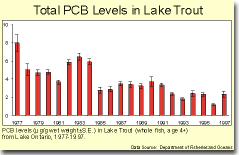We have come a long way in improving the conditions in the Great Lakes since the low point in the late 1960s. For example, the overall contaminant picture has improved dramatically since the early-1970s, with significant declines in environmental concentrations of most of the critical contaminants for which data are available. Some bird species that were thought to have been lost forever from the region, such as the Bald Eagle and Peregrine Falcon, are beginning to return and even nest. The breeding populations of other species, including Osprey and Cormorants, are increasing. Fish communities are also improving, with species such as Lake Trout showing signs of recovery in most of the Lakes, including a self-sustaining population in Lake Superior.
|
Notable Great Lakes Achievements!
|
 However, even with these improvements there is still a long way to go. We must recognize that although large percentage reductions have been achieved for many contaminants in comparison to peak levels, an additional ten fold reduction may be needed to reach acceptable levels of risk. Some contaminants that have been banned in the Great Lakes region are still being transported into the region from long distances via the atmosphere. Equally important are the non-chemical stresses on the ecosystem such as competition from exotic (or non-native) species, habitat loss and the widespread trend towards suburban sprawl.
However, even with these improvements there is still a long way to go. We must recognize that although large percentage reductions have been achieved for many contaminants in comparison to peak levels, an additional ten fold reduction may be needed to reach acceptable levels of risk. Some contaminants that have been banned in the Great Lakes region are still being transported into the region from long distances via the atmosphere. Equally important are the non-chemical stresses on the ecosystem such as competition from exotic (or non-native) species, habitat loss and the widespread trend towards suburban sprawl.
 | SOLEC 2002 SOLEC 2000 SOLEC '98 SOLEC '96 SOLEC '94 |
Related sites on the State of the Great Lakes Basin Ecosystem
Lakes Erie, Superior and Ontario Lakewide Management Plans
Lake Huron Initiative
Binational Remedial Action Plans
Great Lakes Atlas
Water Quality in Ontario Region




